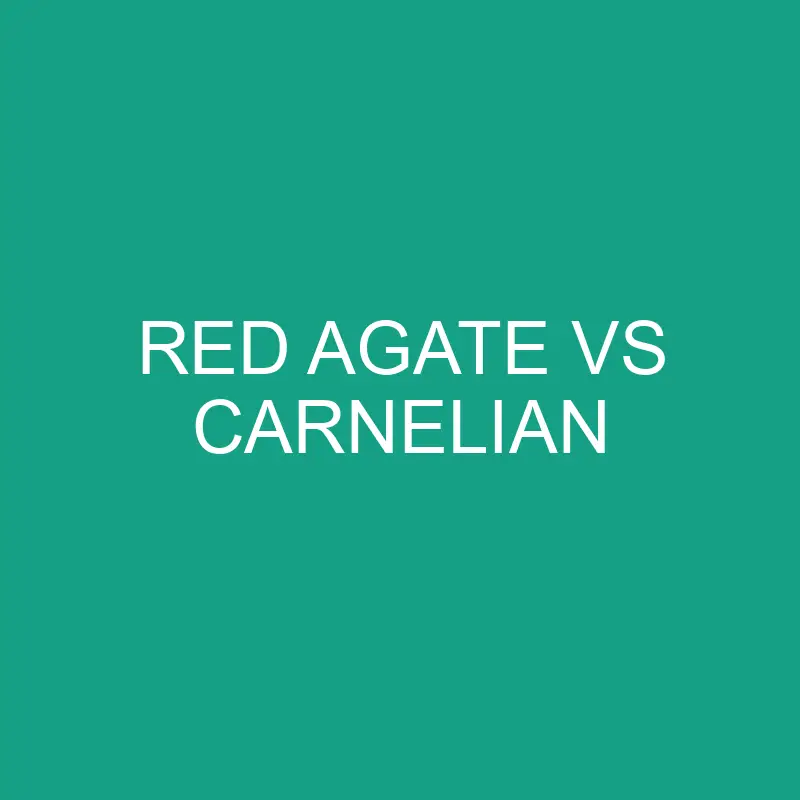Unveiling the Fiery Elegance of Red Gemstones
In the kaleidoscope of gemstones, the color red is synonymous with passion, energy, and a fiery elegance that captures the imagination. Among the spectrum of red gemstones, Red Agate and Carnelian stand out, each with its unique characteristics, historical significance, and metaphysical properties. In this exploration, we will delve into the distinct qualities of Red Agate and Carnelian, unraveling the mysteries behind these captivating red gemstones.
Post Contents
Red Agate: A Tapestry of Natural Patterns and Energy
Origins and Geological Background:
- Composition: Agate is a variety of chalcedony, which is a form of quartz. The red color in Red Agate is often due to the presence of iron oxides.
- Formation: Agate forms in volcanic rock cavities through the deposition of silica from groundwater. The distinctive banding and patterns in agate result from successive layers of mineral deposits.
Physical Properties:
- Color and Appearance: Red Agate can exhibit a range of red hues, from deep crimson to warm rust tones. Its most notable feature is the characteristic banding or patterns that can be present.
- Transparency: It is typically translucent to opaque.
- Crystal Structure: Agate belongs to the hexagonal crystal system, sharing its structure with quartz.
- Hardness: On the Mohs scale, Agate has a hardness of 6.5 to 7.
Origins and Mining:
- Locations: Agate deposits are found worldwide, and Red Agate can be sourced from places such as Brazil, Mexico, India, and the United States.
- Mining: Extracted through traditional mining methods, Red Agate is valued for its use in jewelry and ornamental objects.
Metaphysical Properties:
- Balancing Energy: Agate is generally believed to have stabilizing and balancing energies, both physically and emotionally.
- Grounding Influence: Red Agate, in particular, is thought to have a grounding influence, helping individuals connect with the present moment.
- Chakra Association: It is often associated with the root chakra, which is linked to stability and a sense of belonging.
Uses in Jewelry and Art:
- Jewelry: Red Agate is used in various jewelry pieces, including rings, pendants, and beads. Its unique patterns make each piece distinctive.
- Carvings and Decorative Items: Larger specimens of Red Agate are often carved into decorative items such as bookends, bowls, and sculptures.
Carnelian: The Warm Glow of Ancient Significance
Origins and Geological Background:
- Composition: Carnelian is a variety of chalcedony, similar to agate. The distinctive orange to reddish-brown color of Carnelian is due to the presence of iron oxide impurities.
- Formation: Like agate, Carnelian forms in the cavities of volcanic rocks, and its color can be influenced by factors such as heat and radiation.
Physical Properties:
- Color and Appearance: Carnelian typically displays warm shades of orange, ranging from pale peach to deep reddish-brown. It may be uniformly colored or exhibit subtle banding.
- Transparency: It is often translucent, allowing light to penetrate and give it a warm glow.
- Crystal Structure: Carnelian, like agate, belongs to the hexagonal crystal system and shares its structure with quartz.
- Hardness: On the Mohs scale, Carnelian has a hardness of 6 to 7.
Origins and Mining:
- Locations: Carnelian is found in various locations globally, including Brazil, India, Madagascar, and the United States.
- Mining: Extracted through mining operations, Carnelian has been used since ancient times for carving and jewelry.
Metaphysical Properties:
- Creativity and Motivation: Carnelian is often associated with boosting creativity, motivation, and courage.
- Vitality and Energy: It is believed to enhance physical vitality and provide a surge of life force energy.
- Chakra Association: Carnelian is linked to the sacral chakra, associated with passion, creativity, and emotional expression.
Uses in Jewelry and Art:
- Jewelry: Carnelian has been popular in jewelry for millennia and is used in various forms, including beads, cabochons, and carved pendants. It was often used in ancient engraved seals and amulets.
- Seals and Amulets: Historically, Carnelian was engraved with intricate designs to create seals and amulets, reflecting its significance in ancient cultures.
Comparative Analysis: Red Agate vs. Carnelian
1. Color Range:
- Red Agate: Displays a range of red hues, often with distinctive banding patterns.
- Carnelian: Typically exhibits warm shades of orange, from pale peach to deep reddish-brown, with or without banding.
2. Transparency:
- Red Agate: Typically translucent to opaque.
- Carnelian: Often translucent, allowing light to create a warm glow.
3. Chalcedony Variety:
- Red Agate: A variety of chalcedony known for its distinctive banding patterns.
- Carnelian: Another variety of chalcedony, often with a more uniform color but may also exhibit banding.
4. Chakra Association:
- Red Agate: Associated with the root chakra, promoting grounding and stability.
- Carnelian: Linked to the sacral chakra, associated with passion, creativity, and emotional expression.
5. Uses in Jewelry:
- Red Agate: Utilized in various jewelry pieces, showcasing its unique patterns.
- Carnelian: Historically popular in jewelry for beads, cabochons, and carved items, including seals and amulets.
6. Metaphysical Properties:
- Red Agate: Believed to have stabilizing and grounding energies, connecting individuals with the present moment.
- Carnelian: Associated with creativity, motivation, and vitality, promoting a surge of life force energy.
7. Historical Significance:
- Red Agate: Valued in various cultures for its ornamental and metaphysical significance.
- Carnelian: Has a rich historical significance, often used in ancient engraved seals and amulets.
8. Global Origins:
- Red Agate: Found in various locations globally, including Brazil, Mexico, India, and the United States.
- Carnelian: Sourced from locations such as Brazil, India, Madagascar, and the United States.
Conclusion: The Allure of Red Elegance
In the realm of red gemstones, the duet of Red Agate and Carnelian unveils a captivating symphony of colors, patterns, and energies. While Red Agate enchants with its intricate banding and grounding properties, Carnelian emanates a warm glow, stimulating creativity and vitality. The choice between Red Agate and Carnelian is a matter of personal preference, as each gemstone weaves its unique tale of elegance, history, and metaphysical significance.

